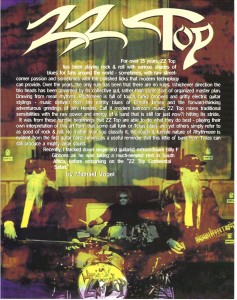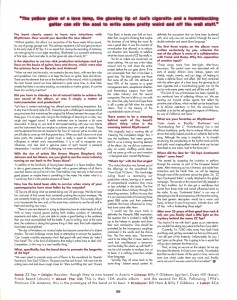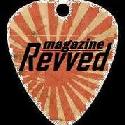
(click on picture to open file)
By: Michael D. Vogel
© September 1, 1996. Michael D. Vogel. All Rights Reserved.
Published in:
The Album Network magazine – September 27, 1996
For over 25 years, ZZ Top has been playing rock & roll with various shades of blues for fans around the world – sometimes, with raw street-corner passion and sometimes with the polished licks that modern technology can provide. Over the years, the only rule has been that there are no rules. Whichever direction the trio heads has been governed by its collective gut, rather than some sort of organized master plan. Drawing from mean rhythms, Rhythmeen is full of tough, funky grooves and gritty electric guitar stylings – music derived from the earthy blues of Elmore James and the forward-thinking adventurous grindings of Jimi Hendrix. Call it modern barroom music; ZZ Top mixes traditional sensibilities with the raw power and energy of a band that is still (or just now?) hitting its stride.
It was from these humble beginnings that ZZ Top are able to do what they do best – play their own interpretation of this art form that some cal funk or Texas blues and yet others simply refer to as good ol’ rock & roll. No matter how you classify it, the rough and tumble nature of Rhythmeen is evident from the first guitar blast serving as a useful reminder that this little ol’ band from Texas can still produce a mighty large sound.
Recently, I tracked down singer and guitarist extraordinaire Billy F. Gibbons as he was taking a much-needed rest in South Africa, before embarking on the “ZZ Top Continental Safari.”
The band clearly seems to have new intentions with Rhythmeen. How would you describe the new album?
Billy F. Gibbons: “Without question, this album is a concoction of the Texas meets Africa sound, by way of grungy garage rock. This perhaps represents a full and genuine return to the early style of ZZ Top. It is no secret that that, during the recording of Antenna, we were going for a raw edge recording. Rhythmeen is a successful embracing of that style, what most refer to as that good old style of early ZZ Top.”
Is the objective to use less slick production techniques and just focus on the basics of guitar, bass and drums, which were also the primary focus on Recycler and Antenna?
BG: “When we went into the studio, we wanted to be very basic, with very few rules and guidelines. Our intention is to keep the focus on guitar, bass and drums. These are the elements that are at the forefront of the record, which is probably the most honest record we’re delivered in quite some time. A close listen reveals that there is no extra tracking, no overdubs or rhythm guitars, it’s just the Texas trio working overtime!”
Did you have to sidestep a lot of natural habits to achieve the raw sound of the album, or was it simply a matter of instrumentation and production?
“Let’s face it, modern technology has offered some tantalizing temptations, But, to stay true to the early style of ZZ, it became quite a challenge to compose actual song structures that maintained the original fat fullness between the scope of just three guys. It is no easy task rising to the challenge of returning to a rude, raw, rough and ragged sound. It really motivates one to become a bit more resourceful. In doing so, you tend to start experimenting with your own talents and the instruments that you employ to achieve your won style of music. These are the elements that are not covered in the ‘How To…’ manual, yet, as an artist; you are still able to come up with that groove focus. When you boil it down to its most basic parts, the creation of good music is really a quest to maintain the willingness to refresh one’s resourcefulness. It is a call to recognize your influences, and also lend a genuine piece of spirit toward a personal interpretation. I would call it challenging, but more motivating.”
With the rise of artists like Kenny Wayne Shepherd, Eric Johnson, and Ian Moore, are you glad to see the music industry turning an ear back to the Texas blues?
“In addition to the familiarity of having been steeped in a Texas tradition, there is also great pressure to follow through with a groovy delivery of all that is assumed Texans can pull out of a hat. That tradition may rest only in that we are good players or maybe there is something in the water. No matter what it is, I would say that it is the positive pressure of Texas.”
How has the band been able to survive when many of your contemporaries have since fallen by the wayside?
“ZZ Top is still doing what we started doing over 25 years ago. We like to have fun, and part of that comes from constantly pushing the musical envelope. We are constantly tinkering with our instruments and amplifiers. This curiosity allows us to incorporate the new, and, at the same time, continue to use the old stuff in fresh and exciting new ways.
”There is one new element in trying to determine how to make heads of it all. With so many musical genres putting forth endless numbers of interesting exponents and styles, if you are able to create a good feeling in the audience, then you have accomplished half the battle. If you’re smiling, and, at the same time, the audience is doing that groove thing in their seat, then both objectives have been accomplished.
“The day of limitations on musical styles has become somewhat of a distant shadow. The real challenge comes back at attempting to answer the question, ‘Can I create a stylistic expression that I feel good with and where do I take it from here?’ This is the kind of dichotomy that today’s artists have to deal with. Competition, in this way is a very healthy thing.”
What, specifically, has the band done to promote the longevity of ZZ Top?
“We were asked to provide some sort of flavor to the soundtrack for Quentin Tarantino’s From Dusk Til Dawn. The pace was fast and furious. We went into the cutting room and laid down rough mixes for ‘She’s Just Killing Me’ and ‘Vincent Price Blues’ in barely over half an hour. After that, we got to thinking that maybe the business of just letting the music fly was a good idea. It was this moment of re-evaluation that allowed us to refocus our direction and, basically, to redefine what the classic sound of ZZ Top really is.
“As far as video’s are concerned, we script nothing. We just toss a few ideas around and try and shoot the entire project before the sun goes down. If we can accomplish that, then it has been a good day. The best projects are those that come off the cuff. We attribute at least 99% of the success to a great management team, exceptional directors and tremendous support, from both the video industry and the record companies. The rest is left to us; we walk on, drive fast, play hard and hope there is still a pretty girl left when the smoke clears. That is the beauty of the unpredictable nature of music.”
There seems to be a meaning behind each of the band’s album titles; what is the meaning behind Rhythmeen?
“We originally had a working title of ‘Nearing The Completion Stage.’ But, it was the backbeat, that mean groove, which hit us as a strong recurring element of the album. So, we did our customary play on words, shuffling words about until we came up with our own invention – a feel-good elixir named Rhythmeen.”
“What’s Up” with the first single?
“Our initial direction was formed out of the offerings on the soundtrack for From Dusk Til Dawn. This hardedge outing found us revamping our production values, leaving us in search of compositional creations that, more or less unfolded in the studio. The first single came about midway through the recording sessions. Suffice it to say, that it is our personal stab at honoring those great R&B artists and their patented methods that have influenced so many that have come after them.
“I would say the music definitely has that Memphis R&B inspiration; but the question that is invoked is really left up to the listener to ponder and draw their own conclusions. One should be provoked by the incongruous couplings contained in the words and the chorus line. The first verse says, ‘Tomorrows want to be today/But it never seems to work that way/Because a tomorrow can’t be today/So what’s up with that?’ It can be a bit complex to analyze, but, at its basic, it is nothing more than simple blues language.
“Lyrically, they all come back to the same thing – blatant sexual content. It’s definitely the accusation that we have been burdened with, and, only now can we admit it through the use of double entendre and secret blues language.”
You wrote the first three tracks on the album, whereas the rest of the album is more of a collaboration with Frank and Dusty. Why this separation of creative input?
“Those songs came from late-night, after hours excursions. The control room was decorated with all sorts of spooky African icons; statues, spears and shields, masks, swords, and juju bags, all helping to create a definite flavor and effect. (All that) combined with the yellow glow of a lava lamp, the glowing tip of Joe’s cigarette and a hummbucking guitar can stir the soul to write some pretty weird and off the wall stuff.
“This kind of raw primitiveness has been injected by our newfound love of collecting African art. We are sending out musical smoke signals that reflect the primitive side of the blues, which we feel can be traced back to its African retentions. In fact, this excursion has enabled us to be the self-appointed agents of Afrikana, by way of California and Texas.”
What are your favorites on Rhythmeen?
“Listen closely to ‘Blackfly,’ ‘Rhythmeen’ and Hummbucking Part 2. ‘Hummbucking’ has a real African backbone, partly due to the antique African tribal drums that really help to provide an authentic feel to the song. Although the song is simplistic in its chordal structuring, the complexities on the rhythm track and the dual pitched vocal singing effect created what can be best describe as one mean, bad-to-the-bone jam.”
Where did the idea for ‘ZZ Top’s Continental Safari’ come from?
“We started by accepting the invitation to perform through the summer as part of the European festival dates. After reviewing our tour itinerary, and aside from Antarctica and the North Pole, we will be stepping through most of the continents across the globe. So, ‘ZZ Top’s Continental Safari’ is really attached to this global campaign. The sounds on this record are fully steeped in ZZ Top’s tradition, but it’s also got a worldliness that comes from those wide and varied influences heard on the radio. To say ‘Continental Safari’ is our way of attempting to be all encompassing with the entire outing. The best generic description would be a warm and fuzzy, sit-down-in-your-living-room, intimate show with ZZ Top – with a foreboding sharp edge!”
After 25 years of that good time rock & roll, can you finally shed a little light on the mystery behind the name ZZ Top?
“You had to hit me with that! I guess as an interviewer, you wouldn’t be doing any justice to the fans if you didn’t.
“Currently, I’m 7000 miles away from both Frank and Dusty and yet they remind me that as of this point, I am still part of the fraternity. Unfortunately, for you, I can’t give up the ghost. This is going to be a secret that will go down between the three of us.
“And, as long as we are on the subject, let me say this about the beards, In Dusty’s own words, ‘It’s probably best that we don’t shave. At this point in time, we not even sure what’s under there any more and, frankly, we’re not sure if we even want to find out either! ^m^
Origin:
Houston, TX, though they’re now based in Austin.
Line-Up:
Billy F. Gibbons – Guitar & Vocals
Dusty Hill – Bass & Vocals
Frank Beard – Drums
About The Current CD:
After a 20-year partnership with Warner Bros., that saw the release of 10 full-length records, this is ZZ Top’s 12th studio album – and the second for RCA. Rhythmeen, the prototype of the band at its best, follows 1994’s Platinum CD Antenna.
Discography:
Rhythmeen – (RCA, 1996) Degüello – (Warner Bros., 1979)
Antenna – (RCA, 1994) Tejas – (Warner Bros., 1977)
Recycler – (Warner Bros., 1990) Fandango! – (Warner Bros., 1975)
Afterburner – (Warner Bros., 1985) Tres Hombres – (Warner Bros., 1973)
Eliminator – (Warner Bros., 1983) Rio Grande Mud – (Warner Bros., 1972)
El Loco – (Warner Bros., 1981) ZZ Top’s First Album – (Warner Bros., 1971)
Produced By:
Bill Ham & Billy F. Gibbons
Label:
RCA
Website:
© September 1, 1996. Michael D. Vogel. All Rights Reserved. This originally appeared on the Vogelism blog at https://www.vogelism.com authored by Michael D. Vogel. This article may be shared or reprinted as long as the entire copyright message, including the source location of this article, accompanies it.














 Welcome to Michael D. Vogel’s online portfolio. I am a Los Angeles-based music journalist/content creator, and self-professed music-fanatic/radio-aholic. With more than 20 years of experience in multiple facets of the music industry including; music programming/air talent for terrestrial and internet radio as well as record label artist promotion, I have a finger on the pulse of what's new and under the radar in the emerging music scene. Areas of specific expertise include, but not limited to: rock (heritage, mainstream, heavy metal/hard rock and alternative), pop and adult contemporary, as well as radio, pop culture, sports, exercise and politics. I am applying my passion for music as a freelance writer for the Examiner as National Music Examiner (Examiner.com) in addition to West Coast Editor for FreeGotham (FreeGotham.com). Find me at michael@vogelism.com.
Welcome to Michael D. Vogel’s online portfolio. I am a Los Angeles-based music journalist/content creator, and self-professed music-fanatic/radio-aholic. With more than 20 years of experience in multiple facets of the music industry including; music programming/air talent for terrestrial and internet radio as well as record label artist promotion, I have a finger on the pulse of what's new and under the radar in the emerging music scene. Areas of specific expertise include, but not limited to: rock (heritage, mainstream, heavy metal/hard rock and alternative), pop and adult contemporary, as well as radio, pop culture, sports, exercise and politics. I am applying my passion for music as a freelance writer for the Examiner as National Music Examiner (Examiner.com) in addition to West Coast Editor for FreeGotham (FreeGotham.com). Find me at michael@vogelism.com. 